| Reviews & Columns |
|
Reviews DVD TV on DVD Blu-ray 4K UHD International DVDs In Theaters Reviews by Studio Video Games Features Collector Series DVDs Easter Egg Database Interviews DVD Talk Radio Feature Articles Columns Anime Talk DVD Savant Horror DVDs The M.O.D. Squad Art House HD Talk Silent DVD
|
DVD Talk Forum |
|
|
| Resources |
|
DVD Price Search Customer Service #'s RCE Info Links |
|
Columns
|
|
|
Film Noir Classic Collection, Vol. 4
THE MOVIES:
"You know, it isn't what a man wants to do, Lacey, but what he has to do." - Sterling Hayden as Detective Sims in Crime Wave
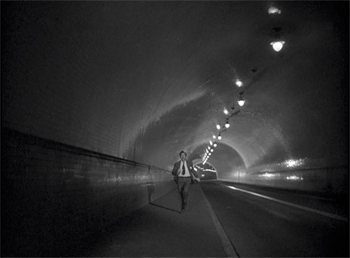
For the last four years, noir fans have been treated to an annual summer pleasure in the form of box sets from the Warner Bros. catalogues. These excellent sets have coupled the best and the most well-known with lesser known titles from the vaults, rounding out our collections of classic crime with many movies that aren't seen that often. This year, the studio takes that mission one step further by doubling the content, giving us five discs with two movies each, an A and B double feature of hardboiled, black-and-white cinema.
Just about every movie here is new to me, including work by respected genre directors like Nicholas Ray, Anthony Mann, Fred Zinnemann, and Don Siegel, and actors like Robert Mitchum, Edward G. Robinson, Robert Ryan, Jane Greer, and Sterling Hayden. Each DVD is an afternoon or evening of pulpy entertainment, complete with bonus features. Is it possible that one of my favorite yearly DVD events has gotten even better?
Disc 1
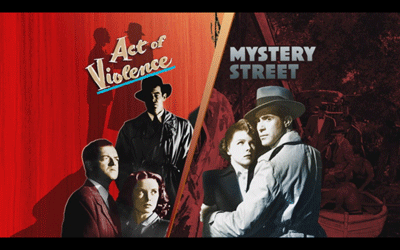
* Act of Violence (1948): A terse, twitchy revenge story with Crossfire's Robert Ryan as trench-coated killer Joe Parkson, who limps into a sleepy California town in order to kill his old army buddy, Frank Enley (Van Heflin). Yet, the brooding gunman and the clean-cut father may not be all that they seem in the topsy-turvy morality of noir. Something happened between the two in a Nazi prison camp, something Enley is not willing to talk about, and bad enough to make him run the second he lays eyes on his old comrade.
Director Fred Zinnemann (Day of the Jackal) cuts Act of Violence so that it's all forward motion. It opens with Robert Ryan retrieving a gun and getting on a bus headed for his bloody destination, and it doesn't stop until that gun goes off. Perhaps more interesting than the men, though, are the women who love them. Frank's wife Edith (Psycho's Janet Leigh) and Joe's girl Ann (Phyllis Thaxter) are the ones who must suffer the real consequences for this male machismo and ego. How they deal with the hidden crimes and the angry choices their lovers make is really what gives Act of Violence its soul. Joe and Frank are beasts who can only settle their grievances one way (the film's title tells it like it is), and it's up to the women to pull them back from the brink.
Act of Violence also has Mary Astor (The Maltese Falcon) as a woman of the world that Frank meets on the wrong side of it. In contrast to the other women, she walks amongst the kind of men Edith and Ann are trying to save their mates from. She takes Frank to meet more killers, pushing him into doing the wrong thing again even as she tries to warn him away. In the noir color scheme, these three women are just as identifiable for their shade of hair as they are their actions. Though Leigh is not yet the bright blonde she's most remembered as, her hair is the lightest (strawberry blonde?), as she represents motherhood and the stable, safe home environment. Ann is the middle, with light brown hair, the city girl who wants the home in the country. Whereas Mary Astor's locks are dark brown. There is no safety where she lives.
As an existential parable, Frank is the least noble because he acts without being prepared to take full responsibility for the fallout. He's letting his prior bad acts define him rather than really taking charge of himself and honestly atoning. Joe may be out for blood, but he's fully aware of the penalties pulling the trigger will bring, and he'll answer for them. Indecision is Frank's fatal flaw. When the two men meet at last on a rain-drenched railway yard, the open space resembles the wide open streets of a Western town (High Midnight?), and Zinnemann places the new American iconography of noir next to the old iconography of the cowboy story. This showdown is full of both ironies and redemptive acts, with both men making divergent decisions that will ultimately determine who they are.
* Mystery Street (1950): Less of a film noir, more of a police drama. It's pretty easy to tell the good guys from the bad guys, and there is nothing of the gnarled ethics that make most good noir films such philosophical riddles. The main thing to recommend Mystery Street is its early look at forensic science. Police detective Peter Morales (Ricardo Montalban) teams up with Harvard professor Dr. McAdoo (Bruce Bennett) to try to figure out who the skeleton they found on the beach belongs to, and how she ended up washed up on shore. There is little mystery to the case of who killed the sexy call girl (Jan Sterling, Ace in the Hole), since rather than backtracking from the discovery of the body, director John Sturges (Bad Day at Black Rock) leads with the girl and her murder. This means we know that the fingered patsy (Marshall Thompson) is just a dummy who doesn't lie too well, and the real killer is kind of a nothing character that barely gets any screen time.
Still, Montalban manages to mix charm with hubris, and it's enjoyable watching him dogmatically pursue the wrong track. The CSI stuff also has a kind of wide-eyed, naïve appeal, and even in this formative stage is more fascinating than the overly flashy modern take TV viewers can't seem to get enough of.
Disc 2
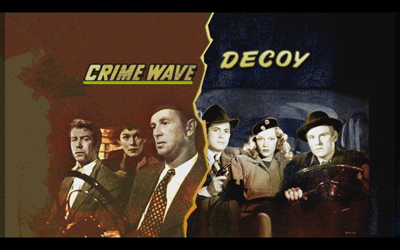
* Crime Wave (1954): Andre de Toth (the original House of Wax) directs an exceptionally tight little thriller about Lacey (Gene Nelson), an ex- who has spent the last two years setting up a straight, clean life. He's got a job and an adoring wife (Phyllis Kirk), but it's all for naught when three of his former prison mates escape from the clink. When a gas station hold-up goes bad, one of them gets shot in the robbery. He tries to get Lacey to help, but dies on his floor instead, giving the unforgiving police detective (Sterling Hayden) who has had it in for Lacey an excuse to try to truss up his favorite parolee.
It's a standard noir trope: man with a shady past tries to make good, but the past is inescapable. Lacey insists he's clean, but the cops won't believe him. He tries to keep from getting embroiled in the outlaws' next big heist, but they have a gun and they say different. The script by Bernard Gordon (Earth Vs. the Flying Saucers), Crane Wilbur (He Walked by Night), and Richard Wormser (The Big Steal) is cut right down to its bone. The story takes place over only a couple of days (minus the three Lacey loses in the pokey) and doesn't take any tangents. Hayden's cop and the remaining crooks are single-minded in their purpose, and it's all Lacey can do to stay on track. de Toth shoots largely on location, never getting too fancy. While he does indulge in shadows and the darkness of his underworld setting, there is also a kind of clinical feeling to the work. The interior halls of the police station, for instance, are lit so bright, they appear sterile. This makes the stuffy life of the men in the system no more appealing than the dirty world of crooks.
Only the outdoors offer any appeal. Lacey is a pilot and he works at an air yard, out in the open with decent people who take you at your word. It's where he wants to be, but he's trapped in the middle, neither crook nor citizen. The film noir dilemma in a simple, invigorating nutshell.
* Decoy (1946): Definitely the B-movie of this double feature, Decoy is an artless, by-numbers picture about a devious mol (Jean Gillie) who orchestrates a rescue of her death-row boyfriend (Robert Armstrong) in order to find out where he hid his big score (he loves her, but apparently not enough to hook her up with the cash when the state punches his ticket). Built on the most dubious of pseudo-science, Gillie enlists a stiff-as-a-board, bored-stiff doctor (Herbert Rudley) to administer a post-mortem antidote that, I kid you not, reverses the effects of the gas chamber. (The drug referenced, methylene blue, is actually an antidote for cyanide, which is the kind of gas California is purported to use in the film, but it most likely works best before you're dead.) A couple of double-crosses puts the dame, the doc, and her new mobster boyfriend (Edward Norris) on the run from a dogmatic cop (Sheldon Leonard) to see who will get the money and who will get a bullet.
This mild diversion was directed by Jack Bernhard, who helmed ten more anonymous movies in the five years following this debut. He doesn't have the skill to hide the cheapness of the production. Written by Ned Young (one of the heavies in Crime Wave) from a story by Stanley Rubin, long sections of Decoy's plot take place in single rooms, while some outdoor scenes are clearly studio backdrops that the filmmakers don't know how to disguise. Bernhard's actors are plodding, and the story moves with little force. They might as well have walked out of town for all the speed with which the crooks flee. Still, Jean Gillie was capable of a certain sex appeal, and there is some amusement to be had in the silly sci-fi of resurrecting the dead convict. You can also have a little fun puzzling over why in the hell the movie is actually called Decoy. Is it the body the bad guys inexplicably refuse to provide for their pilfered corpse, the only reason anyone notices the scheme is underway? Is it the final payoff? Or was it just that Bernhard, who also produced the picture, thought it would look good on the poster? The world may never know...
Disc 3
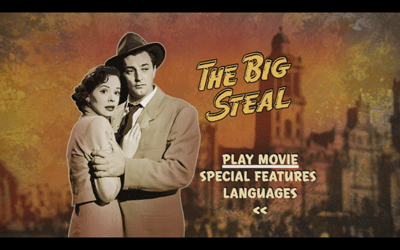
* Illegal (1955): Lewis Allen (A Bullet for Joey) directs the third remake of the Frank J. Collins play The Mouthpiece, about an unstoppable district attorney who ends up on the wrong side of the law. Edward G. Robinson plays Victor Scott, whose win record has him on track for the governor's mansion until he sends an innocent man (DeForest Kelly) to the electric chair. Rather than seek redemption, Scott decides instead never to send another innocent man up the river and dives right into the deep end, becoming a defense attorney for mobsters. Eventually, he'll have to see how much goodness a man can hang onto once he's rejected his righteous path, as his adopted daughter and protégé Ellen (Nina Foch, Executive Suite) ends up wrongfully charged for murder. Can he reject his new lifestyle and get her out of this fix?
Edward G. Robinson is the main selling point of Illegal. On screen, he's positively convincing as a bulldog of a man who is as tenacious pursuing justice as he is subverting it. The switch from good guy to bad guy is an extreme one in W.R. Burnett and James R. Webb's script. (The two men are quintessential hardboiled writers, creating The Asphalt Jungle and Cape Fear, respectively, among other things.) Once he decides he's in it just for the money, he goes for every last dollar he can get his hands on. Robinson is easily parodied, but the imitators and impressionists miss how soulful the actor really is. His character breaks twice in the picture, first when he realizes he convicted the wrong man and second when he realizes that his underhanded dealings have leaked over to his former life. The film isn't necessarily high on visual style, but Robinson needs no trappings to carry our attention.
Keep an eye out for Jayne Mansfield making her film debut, an auspicious appearance as a mob moll akin to Marilyn Monroe's turn in The Asphalt Jungle.
* The Big Steal (1949): One of the earliest films of legendary tough-guy director Don Siegel (Dirty Harry), The Big Steal is perhaps more important for reteaming the marvelous duo of Robert Mitchum and Jane Greer. In the classic Out of the Past, Mitchum played a bad guy trying to do good but whose head was all mixed up by Greer's big, dark eyes. For The Big Steal, they are both the good guys, having been done wrong by the same cad. Jim Fiske (Patric Knowles) is Greer's fiancée, but he stole $2K from her and ran to Mexico. Small potatoes compared to the $300K he took from Mitchum and the U.S. Army, leaving his buddy holding the bag.
Essentially, The Big Steal is a chase picture. Mitchum and Greer pursue Fisk through Mexico, while Capt. Blake (the excellent character actor William Bendix) pursues Mitchum on behalf of the Army. Meanwhile, the Mexican police sit back and watch the Americans spin in circles, ready to wrangle whoever is left standing when the big pile-up eventually happens. Don Siegel makes great use of the south of the border setting, including making numerous jokes about his hero's inability to understand the language. Using the wide-open expanse of the Mexican countryside, he films cars speeding over dusty roads, bounding into ditches, windows shattering from gunfire. The fight scenes are also plenty realistic, full of fumbles and knock-downs, an early example of the kind of action Siegel would become famous for.
All in all, an entertaining movie. A fast-talking hero, a dame who is no pushover, and a little romance amongst the fisticuffs.
Disc 4
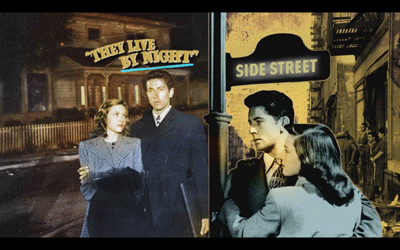
* The Live By Night (1948): The first feature from director Nicholas Ray, it prefigures his iconic Rebel Without a Cause as a story about two doomed teenagers who fall in love despite the circumstances that put them on the wrong side of an adult world that either doesn't understand or refuses to try. Adapted from the Edward Anderson novel Thieves Likes Us (also made into a later film by Robert Altman), They Live By Night stars Farley Granger (Rope) as Bowie, a kid who got into some trouble when he wasn't looking for it, and he has broken out of jail with older bank robbers who also had life sentences for murder. On their backwoods crime spree, Bowie meets Keechie (Cathy O'Donnell, The Best Years of Our Lives), and their reaction to each other is romantic, hormonal, and strangely endearing and comforting. Keechie tries to find solutions to get Bowie out of his trouble, but the newspapers have seized on him as some kind of pretty boy highwayman, putting the lives of the two young lovers beyond their own grasp.
That kind of foreboding permeates They Live By Night. Ray harnesses the adolescent us-against-the-world feeling of doom and gloom and wraps the entire picture in it like a cloth. It doesn't matter what Bowie and Keechie try to do, they can't live in isolation. A water pipe might burst and the plumber will recognize the young thief, or a former ally might get an itch for some kind of reward and turn snitch. Even Ray's camera acts as an otherworldly force, with his pioneering helicopter shots careening over the fleeing couple, showing just how much larger their surroundings are than a pair of kids in love. They live by night because the daylight means exposure.
By the end of the film, the phrase "thieves likes us" has become a kind of mantra. Bowie has to accept that a thief is what he is now, there is no use struggling. It's a cold ending for the boy, because once he gives in, the shields come down, and the punishment that is meted out to such tragic figures arrives with swift ferocity.
* Side Street (1950): They Live By Night opens with tight close-ups of the lovers clutching one another as words on the screen inform us that they have been stranded in a world that hasn't allowed them their right to grow up. In similar fashion, Anthony Mann's Side Street has an all-pervasive narrator whose almost wry tone suggests that here, too, there are elements of fate that extend beyond what we can choose for ourselves. In fact, as the ersatz hero of the story will learn, one false move ends up having reverberations, setting off a chain of events that could be impossible to undo.
Side Street reteams Farley Granger and Cathy O'Donnell as another pair of young newlyweds. Joe and Ellen Norson aren't that different than Bowie and Keechie from Night, except they live in New York instead of the hills and they started out by trying to live right, but the payoff hasn't been very good. Ellen is pregnant, but after a stint in the army and a failed business venture, Joe can only find part-time work as a postal carrier. He dreams of buying his beloved wife a fur coat, but he can't even afford their own apartment. On his delivery route, he sees that a lawyer keeps cash stashed in his office. Thinking he'll be stealing only enough to get by, Joe returns to rob the place. Only, when he checks the stash, it's actually $30,000. Unbeknownst to Joe, the crooked lawyer and his heavy have blackmailed a rich pervert, and the girl that lured the patsy to his doom has ended up dead. Yup, poor Joe is in over his head.
Tough-guy director Mann, working from a script by Sydney Boem (The Big Heat), arranges his various plot points like pieces in a game, each character moving across the giant playing field, no less than New York City itself. Shooting on location, Mann takes us through the streets of Joe's troubles, mixing the semi-documentary style of Jules Dassin's The Naked City with the nervous, feral atmosphere of the noir masters (something Dassin was also pretty good at, particularly in Night and the City). There's nobody in this film that Joe and Ellen can trust, not even the police, who though righteous in their duties aren't necessarily compassionate. Friends will rob you, knowing little kids will sell you out for ice cream money, and life isn't worth very much at all. And yet, despite his brutal directing hand, Mann always has a weird 1950s innocence to him. As much as Joe flails about, there is a kind of safety in Mann's tone. It's like he's that smart little kid with the info, who even tries to school the police in how to resolve the situation. He knows how it's all gonna turn out, not to worry. It's also the comfort of genre: we have certain marks to hit, and Mann is going to get us there.
Disc 5
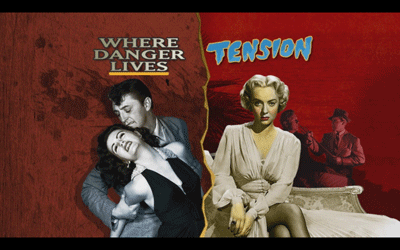
* Where Danger Lives (1950): Cats are bad omens. When straight-laced Dr. Jeff Cameron (he tells bedtime stories to sick children) first goes to see Margo Lannington (Faith Domergue, famous as one of Howard Hughes' girlfriends) at her mansion, a hungry Siamese is perched on her front step. The butler informs Jeff that it's the neighbor's cat, and it's not permitted indoors. Given that Jeff is played by Robert Mitchum, you'd think the cat has met his match. Yet, the next time we see Jeff at Margo's house, he has gotten drunk and has every intention of telling Margo's domineering father (Casablanca's Claude Rains) that he intends to marry the girl whether the rich old fart likes it or not. This time, the cat gets inside, and all hell breaks loose.
In fact, we'll later discover that it's the cat that lead to the discovery of the body of Margo's murdered father, who it turns out isn't really her father. It's one of many times that director John Farrow (The Big Clock) will drift away from the main action to wryly inform his viewer that the decision that his hapless hero and femme fatale just made is not just the wrong one, but an unnecessary one. As Jeff and Margo go on the lam, hightailing it for Mexico in order to escape a murder rap, it makes one think of the old propaganda, often lampooned in Looney Tunes cartoons: "Is This Trip Really Necessary?" Unfortunately for poor Jeff, woozy from a concussion and ridiculously in love, it's not.
Farrow and Hitchcock-scribe Charles Bennett deliver us a story that is as twisted and emotionally desolate as the road to Mexico that threatens to do the couple in. They also provide us with one of the best symbols for hope in all of noir: the single white rose that Jeff gave to Julie, his former girlfriend (Maureen O'Sullivan, Farrow's real-life wife), before he jilted her for Margo. It's the image that will eventually call Jeff back from the brink. There is a delicious irony in the fact that the doctor who abandoned love for madness has his body fail on him the further he gets from his proper life. Suffering a concussion, he slowly becomes paralyzed during his flight from the law, blind to Margo's instability--but then, when hasn't a beautiful woman disguised her troubles from some dumb lug via seduction? There's also a great duality in the fact that early in the picture, Jeff and Julie, who is a nurse, are often seen in surgical masks. They openly wear a covering to protect themselves from infection, whereas Margo, who is brought to them as a failed suicide, proclaims to show herself to the world as she really is. Naturally, it's the reverse, and Jeff's removal of the mask is his removal of his own common sense.
* Tension (1950): Though the B-side here, it's the kind of fabulously lurid second-tier picture that made most cineastes love B-movies in the first place. Right from the get-go, director John Berry and writer Allen Rivkin let us know that this isn't quite the normal picture. It starts with Police Lt. Collier Bonnabe (Barry Sullivan, The Bad and the Beautiful) introducing himself, talking straight into the camera, and explaining his investigative technique: applying pressure on the players in his case until the tension forces one of them to break.
The plot is pure potboiler. Four-eyed wimp Warren Quimby (Richard Baseheart, He Walked By Night) runs an all-night drug store where his glamorously bored wife Claire (Audrey Totter, The Set-Up) reads magazines and picks up men with more money. When she eventually leaves her hubby for big shot Barney Deager (Lloyd Gough), Warren finally mans up--by becoming an entirely different man. He creates the persona of Paul Southern, a fictitious tough guy who will kill Deager and then disappear. Naturally, there are going to be some unforeseen roadblocks along the way. Namely, Mary, played by a warm and alluring Cyd Charisse, who makes Paul/Warren forget all his troubles. Too bad Deager ends up dead anyway, and Claire returns with a vengeance.
Tension crackles with a wicked glee. John Berry knows how sumptuous this plot is, and he squeezes it for all of its juice. Barry Sullivan has a natural smarm, and Audrey Totter is firy and sexy. The script is full of twists and double-ups and though we have a pretty good idea where the comeuppance is going to land its swing, the way we're going to get there is not one that we can anticipate. All the while, though, Sullivan keeps returning, snapping his rubber band, reminding us of what he's up to. It's his movie to control, as much as Totter's character thinks it's hers, and he moves the others around until he finds the right combination, and that rubber band snaps.
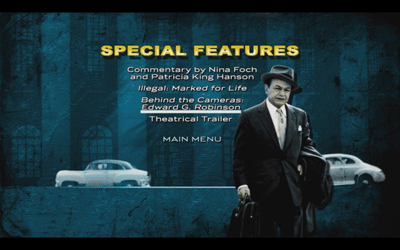
THE DVD
Video:
Nine of the ten movies are in 1.33:1 full screen aspect ratio. The tenth, Illegal, is in letterboxed widescreen and somewhat ironically is the one transfer with the most problems. It's often grainy and at other times spotty and dirty. The full-screen transfers are much more crisp, with only the rarest of hinky scenes. Some edge enhancement does show up, but it's not drastic. Of these, I'd say They Live By Night has the most issues, with some really hazy scenes where the focus goes soft in addition to some image noise. Next to that, Tension probably has the most scratched sequences. The rest didn't have enough to really stand out.
The set-up for each disc begins with a main menu that is a split-screen for both movies featured. Select the one you want, and the DVD takes you to an individual menu for that film, where you can choose to play it, select your audio options, or look at the special features. There are no scene selection menus, nor is there any way to have the double-bill run back to back.
Sound:
Solid 2.0 audio mixes make these films all sound crisp and fresh. Each movie also has two subtitle options: English and French.
Extras:
The bonus features on the set are consistent from disc to disc, film to film, so no great need to cover each of them individually.
First, each flick gets a short documentary about the feature, running an average time of about five minutes (some as short as four-and-a-half, some as long as six-and-a-half). These round up a variety of critics (Richard Schickel, Alain Silver, Elizabeth Ward, Glenn Erickson, Molly Haskell, Patricia King Hanson, James Ursini), enthusiasts (Dick Cavett), participants both living and dead (writer Stanley Rubin, cinematographer John Alton, actresses Maureen O'Sullivan and Audrey Totter), and filmmakers (Oliver Stone, Christopher Coppola) to talk about the movie at hand, backed up by clips from the film, archival photos, and vintage interviews. They are concise, but informative.
Every film also gets a commentary, some with unique contributors, as well as several repeat offenders. Many of them are also involved in the little making-of featurettes, such as on Decoy, where the historian Glenn Erickson and the original author of the film's story, Stanley Rubin, pull double duty on both extras. The list of commentators and their films is as follows:
* Dr. Drew Casper on Act of Violence. This UCLA film professor has a lot of good things to say, but geez, he's hyperactive. (Anybody else see Ed Wynn's face when he talks?) Even so, snarky jokes aside, it's a good commentary and includes a really incisive intro to noir in the first twenty minutes.
* Alain Silver and Elizabeth Ward on Mystery Street, as well as on Tension, on which they team up with actress Audrey Totter. The latter actually is two audio tracks mixed together. Though Silver and Ward, who co-edited a noir encyclopedia, sit and talk together, the bits with Totter were recorded earlier when she watched the film with Ward. Her reminiscences are cut into the pair's critical analysis. (Though there is far less Totter than anyone else.)
* Novelist James Ellroy and noir theorist Eddie Muller on Crime Wave. It's a lively conversation, as both have encyclopedic knowledge of old Los Angeles and of crime films and fiction. Interesting to note, this was actually recorded sometime in 2006 before De Palma's The Black Dahlia, adapting Ellroy, was released, and the author puts what we see on screen in context with his own fiction. A big raspberry to Warner Bros., however, for bleeping the swearing in the commentary. For all the kids who would rent Crime Wave, apparently.
* Screenwriter Stanley Rubin and historian Glenn Erickson on Decoy. It should be noted that Erickson is actually our own awesome critic, DVD Savant. He liked Decoy more than I, and you should read his review of it. He and Rubin get on well, and their conversation is as much a story of the writer's life and what it was like to work in low-budget Hollywood in the 1940s as it is the history of Decoy.
* Actress (and now film professor) Nina Foch and AFI curator Patricia King Hanson on Illegal. Foch is perhaps too honest in her dismissing certain aspects of this film. Hanson tries valiantly to talk about the movie with some respect, and even gets credit for such from Foch, but the actress slaps the movie down at every turn.
* Richard B. Jewell on The Big Steal. Another UCLA professor, Jewell sticks very close to the production, giving us all the dirt on how the movie came about--including how Robert Mitchum's marijuana arrest got the movie fast-tracked by Howard Hughes.
* Eddie Muller returns with actor Farley Granger for They Live By Night. Granger is a great dance partner for the critic, telling lots of dishy anecdotes about the movie and working with Nicholas Ray.
* Critic Richard Schickel holds court on Side Street. Schickel is one of the best, so we get a really detailed analysis of the movie, as well as excellent background information on the production and the participants.
* Film Noir Reader editors Alain Silver and James Ursini engage in a relatively scholarly discussion of Where Danger Lives.
In addition to the other extras, Illegal also has a period television segment from Warner Bros. Presents, hosted by Gig Young and featuring the studio's on-set legal consultant and Edward G. Robinson. In addition to clips from Illegal, this eleven-and-a-half minute piece also has clips from The Life of Emile Zola and The Court-Martial of Billy Mitchell.
Finally, Warner provides us with the original theatrical trailers for all the films except Decoy and They Live by Night.
The five DVDs in the set come in standard-sized plastic cases, slid into a color-printed cardboard slipcover. I know some people didn't like the use of the slim cases on volume 3 of the series, but this is back to the original format.
FINAL THOUGHTS:
DVD Talk Collector Series. For their fourth Film Noir Classic Collection, Warner Brothers does what they didn't have to do: take an already exemplary archival series and make it even better. Upping the ante as far as number of films and the amount of film-specific extras, the studio has surpassed its own untouchable reputation for paying respect to one of cinema's most cultish genres. Structuring each DVD as an A-picture and B-picture double bill means we get more of the guns, gambits, and gorgeous gams that film noir fans love. This new strategy doesn't mean we get some low-level flick forced on us if we want the more prominent feature, however. Out of the five discs, only two of them have an obvious "B," which is a pretty fantastic ratio. Of the DVDs, the Illegal/Big Steal and They Live By Night/Side Street twofers are must-owns all by their lonesome, but pass up the whole thing at your own peril. Life in a noir world is about choices, kid, and if you make the wrong one, you'll only live--or die--to regret it.
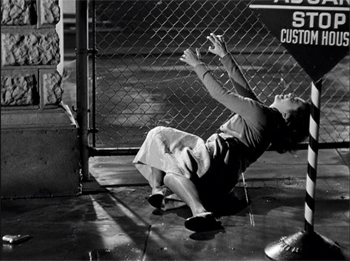
Jamie S. Rich is a novelist and comic book writer. He is best known for his collaborations with Joelle Jones, including the hardboiled crime comic book You Have Killed Me, the challenging romance 12 Reasons Why I Love Her, and the 2007 prose novel Have You Seen the Horizon Lately?, for which Jones did the cover. All three were published by Oni Press. His most recent projects include the futuristic romance A Boy and a Girl with Natalie Nourigat; Archer Coe and the Thousand Natural Shocks, a loopy crime tale drawn by Dan Christensen; and the horror miniseries Madame Frankenstein, a collaboration with Megan Levens. Follow Rich's blog at Confessions123.com.
|
| Popular Reviews |
| Sponsored Links |
|
|
| Sponsored Links |
|
|
| Release List | Reviews | Shop | Newsletter | Forum | DVD Giveaways | Blu-Ray | Advertise |
|
Copyright 2024 DVDTalk.com All Rights Reserved. Legal Info, Privacy Policy, Terms of Use,
Manage Preferences,
Your Privacy Choices | |||||||














